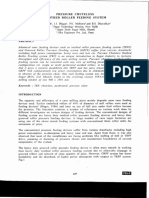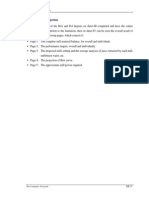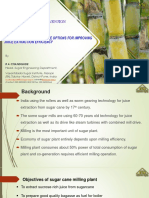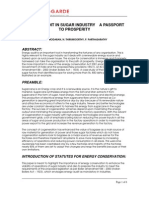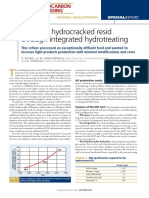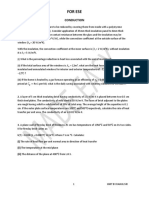KJHG
KJHG
Uploaded by
Sandeep YäðävCopyright:
Available Formats
KJHG
KJHG
Uploaded by
Sandeep YäðävOriginal Description:
Original Title
Copyright
Available Formats
Share this document
Did you find this document useful?
Is this content inappropriate?
Copyright:
Available Formats
KJHG
KJHG
Uploaded by
Sandeep YäðävCopyright:
Available Formats
SASTA Laboratory Manual p 1/18
CHAPTER 1
Definitions and important
formulae used in sugar factories
The definitions presented in this section represent the most commonly used terms in the
South African sugar manufacturing industry. No attempt has been made to include
agricultural terms, as these would be beyond the scope of this document.
A number of important formulae have been included in this section. Where relevant,
references to the original author ’s work have been included to facilitate any further
referencing of the calculations/derivations.
AFFINATION
The removal of the layer of molasses from raw sugar crystals through the addition of a
syrup and then centrifuging – with or without wash water.
ASH
Carbonated ash: the residue remaining after incineration of a sample at 650°C.
Sulphated ash: the residue remaining after incineration of a sample that was pretreated
with sulphuric acid at 650°C.
Conductivity ash: the figure arrived at by correlating the specific conductance of a sample
in solution with its sulphated ash value.
BAGACILLO
Very small particles of bagasse separated either from pre-clarification juices or from final
bagasse. Bagacillo is mainly used as a filter aid with rotary vacuum filters and thus
forms part of filter cake.
BAGASSE
The fibrous residue obtained after crushing cane in a mill is referred to as bagasse.
Depending on the number of the mill it is obtained from, the bagasse is referred to as
first mill bagasse, second mill bagasse, etc. The residue obtained after a diffuser is called
diffuser bagasse or megasse. The final residue obtained from a milling train or from the
dewatering mills of a diffusion plant is called final bagasse but is generally referred to
simply as bagasse.
BAGASSE EXTRACT
For the calculation of pol and Brix in bagasse, a sample of bagasse is blended with water
in a cold digester, filtered and analysed. The liquid fraction so obtained is referred to as
bagasse extract.
BOILING HOUSE
The boiling house refers to the section of the factory in which mixed juice is converted to
raw sugar. It is also referred to as the back-end or raw house.
Revised July 2005 Chapter 1: Definitions and formulae
SASTA Laboratory Manual p 2/18
BOILING HOUSE RECOVERY
Boiling house recovery (BHR) is the ratio of pol actually recovered in sugar to sucrose (or
pol) in mixed juice expressed as a percentage. If based on pol in mixed juice this value is
referred to as Boiling House Pol Recovery.
BROWN LIQUOR
A refinery liquor after the primary decolourisation process.
BRIX
Brix is also referred to as soluble solids.
Brix is the percentage by mass of soluble solids in a pure sucrose solution. In all other
sugar-containing solutions Brix represents the apparent solids according to the Brix
scale. The term Brix is used as if it was a real material and is used in calculations as a
measure of substance, e.g. tons Brix.
Refractometer Brix is the solids concentration by mass of a sucrose-containing solution
obtained using a refractometer. The measurement is based on the relationship between
the refractive index and the percentage by mass of total soluble solids of a pure aqueous
sucrose solution at 20°C measured in degrees Brix (°Bx) (refer to Table 3 in the
Appendix).
Refractometer Brix is also referred to as refractometer solids or refractive dry solids (RDS).
BRIX FACTOR
See DAC Factors
BRIX-FREE WATER
Brix-free water is the sorption water associated with the fibre in cane and bagasse. In
some respects this water behaves in a manner similar to water of hydration and is not
available for dissolving sucrose. This water can be driven off at elevated temperatures but
the fibres will rehydrate when left exposed to atmospheric humidity. In general, the
amount of Brix-free water is assumed to be 25% on dry fibre.
BULK DENSITY
Bulk density is the mass of material per unit of volume occupied. Some useful values are:
Shredded cane on the carrier 280 kg/m 3
Cut whole stick cane loosely piled 200 kg/m 3
Chopped cane from harvesters 350 kg/m 3
Piled bagasse 200 kg/m 3
Piled raw sugar 880 kg/m 3
CANE TO SUGAR RATIO
The cane to sugar ratio refers to the tons cane required to produce one ton of tel quel
sugar.
Revised July 2005 Chapter 1: Definitions and formulae
SASTA Laboratory Manual p 3/18
CARBONATATION/CARBONATION
Carbonatation is the process of colour removal through the introduction of CO2 gas into a
juice or syrup. A crystalline calcium carbonate floc is formed which on precipitating
removes non -sugar (colour) bodies. The term carbonation is sometimes also used.
CLARIFICATION
Clarification is the process in which suspended matter and air are separated from mixed
juice, traditionally by liming, heating and flashing, to produce clear juice. The
combination of liming, heating and flashing is called defecation.
COBENZE’S DIAGRAM
This diagram is used in boiling schemes for the calculation of the relative quantities of
two products to give a mixture of the required purity according to:
A D
C
B E
where A ≡ purity of product 1
B ≡ purity of product 2
C ≡ purity wanted for the mixture
D ≡ quantity of product 1
E ≡ quantity of product 2
C-B=D
A-C=E
CONSIGNMENT
A consignment of cane refers to the total batch of similar cane delivered by a single grower
at any one time. In the cane payment system, a consignment is assigned a single set of
analytical results.
CORRECTED REDUCED BOILING HOUSE RECOVERY (CRB)
The Corrected Reduced Boiling House Recovery (CRB) formula provides an indication of
the Boiling House Recovery (BHR) given a constant cane quality. This yields a recovery
index independent of cane quality, allowing for inter-factory comparisons. The formula
incorporates an SJM recovery calculated using a mixed juice purity of 85%, and a
molasses purity as per the TPD formula.
S × (J - M) 49.8 - TPD
CRB = BHR − 100 × ×
J × (S - M) 0.5493 - 0.008543 × TPD
where BHR ≡ actual sucrose boiling house recovery obtained
S ≡ actual sugar purity
J ≡ actual mixed juice purity (gravity purity)
M ≡ actual final molasses gravity purity
Revised July 2005 Chapter 1: Definitions and formulae
SASTA Laboratory Manual p 4/18
TPD ≡ the target purity difference given by the difference between
the actual molasses purity and a target molasses purity as
calculated by the target purity formula, but using the mixed
juice reducing sugars to ash ratio
Lionnet GRE and Koster KC (1986). A boiling house recovery formula independent of
juice quality. Proc S Afr Sug Technol Ass, 60: 30 - 32.
CORRECTED REDUCED EXTRACTION (CRE)
The Corrected Reduced Extraction (CRE) formula provides an indication of the Extraction
given a constant cane quality (13.0 pol % cane and 15.5 fibre % cane). It attempts to
provide an extraction index independent of cane quality, allowing for inter-factory
compa risons.
(100 - E) × (100 - F) P 0.6
CRE = 100 − 0 .03936 ×
F
where E ≡ pol extraction
F ≡ fibre % cane
P ≡ pol % cane
Rein PW (1975). A statistical analysis of the effect of cane quality on extraction
performance. Proc S Afr Sug Technol Ass, 49: 43 - 48.
CRYSTAL CONTENT
The crystal content of a sample is the percentage by mass of crystalline sugar present in a
massecuite, magma or similar material.
The formula for the calculation of the crystal content of a massecuite is as follows:
massecuite purity - molasses purity
Crystal Content = × massecuite Brix
100 - molasses purity
Note that the molasses purity used in the formula is the nutsch purity, and not the
centrifugal molasses purity.
CRYSTAL RECOVERY (XRE)
A measure of the efficiency of a factory (cane to sugar), taking into account cane quality
(including the type of non-sucrose in the incoming cane). It is calculated by dividing the
actual quantity of crystal produced as sugar, by the theoretical crystal that could have
been recovered from the cane.
T 100
XRE = 100 × x ×
Tc MERC % cane - (1 - a) × S
and
MERC % cane = S − b × N − c × F
where MERC ≡ modified estimated recoverable crystal (ERC) formula
Tx ≡ tons crystal actually produced
Revised July 2005 Chapter 1: Definitions and formulae
SASTA Laboratory Manual p 5/18
Tc ≡ tons cane
S ≡ sucrose % cane
N ≡ non-pol % cane
F ≡ Fibre % cane
a ≡ ‘a’ parameter from the ERC formula
b ≡ adjusted ‘b’ parameter from the ERC formula;
accommodates the reducing sugars to ash ratio in molasses
c ≡ ‘c’ parameter from the ERC formula
Peacock SD and Schorn PM (2002). Crystal recovery efficiency as an overall measure of
sugar mill performance. Proc S Afr Sug Technol Ass, 76: 544 - 560.
CUSH-CUSH
The fibrous material removed from mill juice by screening.
DAC
DAC stands for the Direct Analysis of Cane. The direct analysis of cane comprises the
calculation of the percentages of pol, Brix and fibre in cane by direct analyses of the
moisture in cane, and the pol and Brix in DAC extract.
DAC EXTRACT
DAC extract is obtained by blending a cane sample with water in a 1:2 ratio in a cold
digester, digesting for a fixed period, and then decanting, filtering and analysing the
resulting mixture.
DAC FACTORS
Brix factor: the percentage ratio of the total Brix in mixed juice corrected for suspended
solids - and where applicable corrected for clarifier mud returns - plus the total Brix in
final bagasse to the total Brix in cane as determined by the direct analysis of cane (DAC).
tons Brix in mixed juice (corrected) +tons Brix in bagasse
Brix factor = × 100
tons Brix in cane by DAC
Pol factor: the percentage ratio of the total pol in mixed juice corrected for suspended
solids - and where applicable corrected for clarifier mud returns - plus the total pol in
final bagasse to the total pol in cane as determined by the direct analysis of cane (DAC).
tons pol in mixed juice (corrected) +tons pol in bagasse
Pol factor = × 100
tons pol in cane by DAC
DEFECATION
Defecation is the traditional method of using liming, heating and flashing for the
clarification of mixed juice.
Revised July 2005 Chapter 1: Definitions and formulae
SASTA Laboratory Manual p 6/18
DEXTRAN
Dextran generally refers to a polysaccharide consisting of glucose units linked
predominantly in α-1,6 positions and is mainly produced by microbial activity such as
the lactic acid bacteria, Leuconostoc mesenteroides. Dextran formation is accompanied by
sucrose loss.
DEWATERING
The removal of a liquid (generally a low Brix juice) from bagasse. Commonly applied to
mill units after a diffuser (dewatering mills).
DISPLACEMENT RATE INDEX (DRI)
A measurement of the preparation of shredded cane. In this technique, a sample of
prepared cane is washed, and the amount of Brix extracted is determined by conductivity
measurements over a fixed period.
Typical DRI values for variously prepared cane samples are:
DRI Value Comments
5 Very fine preparation
5-7 (6) Well prepared cane (target value)
12 Coarsely prepared cane
DRY SOLIDS
Also referred to as total solids, dry substance or solids by drying.
Dry solids is the material remaining after drying a product to constant mass, or for a
specified period. The mass of dry substance can also be found by deducting from the
mass of the product the mass of total moisture, as determined using vacuum oven drying
or the Karl Fischer method. This is known respectively as vacuum oven dry solids or Karl
Fischer dry solids.
ESCRIBED VOLUME
The volume escribed by a pair of mill rolls in a given time. It is equal to the roller length
(in metres) multiplied by the work opening (in metres) multiplied by the surface speed of
the rolls measured at the mean circumference (in metres per second) and is expressed in
m 3 /sec.
ESTIMATED RECOVERABLE CRYSTAL
Estimated recoverable crystal (ERC) is an index indicating cane quality by calculating the
percentage of crystal recovery that is actually possible from the given sample of cane.
ERC % cane = a × S − b × N − c × F
where S ≡ sucrose % cane
N ≡ non-pol % cane
F ≡ fibre % cane
a ≡ constant representing the fraction of sucrose leaving the
factory in bagasse, sugar or molasses; it therefore
Revised July 2005 Chapter 1: Definitions and formulae
SASTA Laboratory Manual p 7/18
represents the loss of pol in filter cake and sucrose in
undetermined loss
b ≡ constant representing the loss of sucrose in molasses per
unit non-sucrose in cane
c ≡ constant representing the loss of pol in bagasse per unit
fibre in cane
Factors a, b and c differ slightly from one season to the next, and the values are
recalculated at the end of every season using weighted averages and assuming that ERC
is equal to the total crystal production of the industry.
van Hengel, A (1974). Proposal for the evaluation of cane and sugar in identical units at
standardised efficiency. Proc Int Soc Sug Cane Technol, 15: 1446 - 1455.
EXHAUSTION
Exhaustion is a measure of the recovery of sucrose in crystalline sugar form across a
particular boiling station (A, B or C).
100 × (massecuite purity - molasses purity)
Exhaustion = × 100
massecuite purity × (100 - molasses purity)
Note that the molasses purity referred to here is the molasses obtained from the
centrifugals.
Massecuite exhaustion is a measure of the recovery of sucrose in crystalline sugar form
from across a massecuite. The molasses purity in this instance would be the massecuite
nutsch purity.
EXTRACTION
Extraction is the ratio of sucrose (or pol) in mixed juice to sucrose (or pol) in cane
expressed as percentage and is an indication of the theoretical efficiency of the extraction
process. If based on pol this value is referred to as pol extraction.
tons sucrose (pol) in mixed juice
Extraction = × 100
tons sucrose (pol) in cane
FACTORY PERFORMANCE INDEX
The Factory Performance Index (FPI) is an index used to rate the overall performance of a
factory, and is defined as the ratio of tons crystal in sugar produced to tons estimated
recoverable crystal in (ERC) cane expressed as a percentage.
tons crystal in sugar produced
FPI = × 100
tons estimatedrecoverable crystal in cane
and
tons raw sugar × crystal % raw sugar
tons crystal in sugar produced =
100
and
crystal % raw sugar = 1.724 P + 0.724 M - 72.4
Revised July 2005 Chapter 1: Definitions and formulae
SASTA Laboratory Manual p 8/18
where P ≡ pol % raw sugar
M ≡ moisture % raw sugar
and
tons cane × ERC
tons estimatedrecoverable crystal in cane =
100
and
ERC % cane = a × S − b × N − c × F
where ERC ≡ estimated recoverable crystal
S ≡ sucrose % cane
N ≡ non-pol % cane
F ≡ fibre % cane
a ≡ ‘a’ parameter from the ERC formula
b ≡ ‘b’ parameter from the ERC formula
c ≡ ‘c’ parameter from the ERC formula
van Hengel, A (1974). Proposal for the evaluation of cane and sugar in identical units at
standardised efficiency. Proc Int Soc Sug Cane Technol, 15: 1446 - 1455.
FIBRE
Fibre is the water-insoluble matter of cane and bagasse from which the Brix-free water
has been removed by drying.
Where associated with Brix-free water, fibre is often called natural fibre.
FILTER CAKE
Filter cake is the bulk residue removed by the filter station and includes mud and any
filter aid such as bagacillo.
FINE LIQUOR
A low colour refinery liquor prior to concentration in an evaporator set. This liquor is
usually obtained after a secondary decolourisation process in the refinery.
FLASHING
Flashing is the process in which the juice is heated in a closed system to just above its
boiling point and flashed by sudden release of the built up pressure in order to remove
unwanted dissolved air. Flashing forms part of the clarification process.
FRUCTOSE
Fructose (also known as fruit sugar) is a monosaccharide and a reducing sugar.
Revised July 2005 Chapter 1: Definitions and formulae
SASTA Laboratory Manual p 9/18
GAS CHROMATOGRAPHY
Generally referred to as GC, gas chromatography is a widely known technique to very
accurately determine the quantity of a specified substance in a sample. GC is routinely
used in the Southern African sugar industry to determine the amount of sucrose, fructose
and glucose in mixed juice.
GLUCOSE
Glucose (also known as grape sugar) is a monosaccharide and a reducing sugar.
GUMS
Gums is a heterogeneous group of compounds that form a precipitate on addition of
acidified alcohol and includes natural sugar cane polysaccharides such as starch,
deterioration polysaccharides such as dextran, other organic compounds such as waxes,
some inorganic compounds (ash) and protein.
HIGH PERFORMANCE LIQUID CHROMATOGRAPHY
Generally referred to as HPLC this is a widely known technique to very accurately
determine the quantity of a specified substance in a sample. HPLC is routinely used in
the Southern African sugar industry to determine the amount of sucrose, fructose and
glucose in molasses.
IMBIBITION
Imbibition is the process in which water or juice is put on bagasse to mix with and dilute
the juice present in the bagasse. The water so used is termed imbibition water. General
terms in use are: single imbibition, double imbibition, compound imbibition, depending
on the manner in which the water and/or juice is added.
IMPURITIES
Impurities generally refer to any substances present other than the main specified
substance.
INTERMIXED CANE
Intermixed cane refers to that portion of cane on a cane carrier originating from the
overlapping of different consignments. Its composition is unlikely to be representative of
any one consignment and it is therefore excluded from consignment sampling.
INSOLUBLE SOLIDS
The mass of solids that does not dissolve in water at elevated temperatures expressed as
percentage on sample (in case of sugars) or percentage on Brix (in case of juices/syrups).
Insoluble solids are also sometimes refe rred to as suspended solids.
Revised July 2005 Chapter 1: Definitions and formulae
SASTA Laboratory Manual p 10/18
INJECTION WATER
Cooling water used in pan or evaporator condensers.
INVERT SUGAR
A 1:1 mixture of glucose and fructose obtained by the hydrolysis or inversion of sucrose.
JAVA RATIO
The percentage ratio of pol % cane to pol % first expressed juice.
Note: In calculating an average pol % first expressed juice, the weighting given to the
individual analyses is on the basis of the tons cane from which the respective first
expressed juice samples were taken.
JETS
A jet is the mother liquor separated from a refined massecuite by mechanical means
(centrifugation). It is distinguished by the same prefixes as the massecuites from which it
is separated (1st, 2nd, 3rd or 4th). The final jet returned to the raw house in a back-end
(annexed) refinery is termed return syrup. In some industries, jets are known as run-offs
(1st run-off, 2nd run-off, etc) or greens. In the South African industry, the term jet is
preferred.
JUICE
Absolute juice: a hypothetical juice, the mass of which is equal to the mass of cane minus
the mass of fibre. It comprises all the dissolved solids in the cane plus the total water in
cane.
Clarified juice: the juice obtained as a result of the clarification process.
Diffuser juice, also called draught juice: the juice that is withdrawn from a cane or
bagasse diffuser.
First expressed juice: the juice expressed by the first two rollers of a tandem.
First mill juice: the juice expressed by the first mill of a tandem.
Last expressed juice: the juice expre ssed by the last two rollers of a tandem.
Last mill juice: the juice expressed by the last mill of a tandem.
Primary juice: all the juice expressed before dilution begins.
Residual juice: the juice left in intermediate or final bagasse.
Secondary juice: the diluted juice which, together with the primary juice, forms the mixed
juice.
Mixed juice: the mixture of primary and secondary juices from the extraction plant
delivered into the juice scales.
Press water: the juice expressed in dewatering diffuser bagasse.
Undiluted juice: all the juice existing as such in the cane; its mass is equal to the mass of
cane minus the combined mass of fibre and Brix-free water.
LIMING
The addition of lime to mixed juice for the purpose of clarification.
Revised July 2005 Chapter 1: Definitions and formulae
SASTA Laboratory Manual p 11/18
MACERATION
In the South African sugar industry the term is synonymous with imbibition. Imbibition is
the preferred terminology.
MAGMA
Magma is a mixture of crystals and sugar liquor produced by mechanical means. Magma
is often used as a seed or footing in the vacuum pans.
MASSECUITE
Massecuite is the mixture of crystals and mother liquor discharged from a vacuum pan.
Massecuites are classified in order of descending purity as A, B, C in raw factories, or
first, second, third, fourth in refineries.
MEGASSE
The bagasse obtained from the discharge of a diffuser before it is dewatered in the
dewatering mills.
MELT
Melt generally refers to dissolved raw sugar prior to the decolourisation steps in a
refinery.
MELTING
The dissolving of sugar crystals – either raw or refined – using hot water (usually
condensate). Steam (low grade vapours) is also often added into the vessel – the remelter
- where the melting is done. Melting is a misnomer, as the intention is to dissolve the
sugar, and not melt it in the true sense of the word (i.e. convert the crystal to the liquid
phase).
MILLING HOUSE
The milling house is that portion of the factory where the extraction equipment is
situated. In the extraction plant sugar cane is separated into juice and bagasse.
MIL L SETTINGS
Mean circumference: mean diameter × π.
Mill ratio: the ratio of feed to discharge work openings.
Set opening: the distance between the circumferences escribed by the mean diameters of
the top roller and feed or discharge roller with the mill running empty. This definition
applies pari passu for the openings between underfeed and top roller and between
pressure feeder rollers.
The mean diameter of a grooved roller is equal to the diameter of the equivalent (same
volume and length) solid roller. In practice the arithmetic mean of the diameters over the
Revised July 2005 Chapter 1: Definitions and formulae
SASTA Laboratory Manual p 12/18
tips of the teeth and at the roots of the grooves (neglecting any Messchaert grooves)
affords a sufficiently close approximation.
Work opening: the work opening is equal to the set opening plus the increase in distance
between the rollers resulting from the lift during milling operations.
MILLING LOSS
Milling loss is the ratio of pol in bagasse to fibre in bagasse expressed as percentage.
MOLASSES
Molasses is the mother liquor separated from a massecuite by mechanical means
(centrifugation). It is distinguished by the same prefixes as the massecuites from which it
is separated (A, B or C).
Final molasses: The mother liquor separated from the final massecuite by mechanical
means. Final Molasses can be used as a cattle feed supplement or as a feedstock in
ethanol plants.
MOTHER LIQUOR
Liquid phase in the massecuite after crystallisation.
MUD
Mud is the material removed from the bottom part of the clarifiers and contains the
settled insoluble solids that are separated from mixed juice during clarification.
NON-POL
Non-pol is that part of the Brix which is not pol. It is often referred to as if it were a real
substance.
NON-POL RATIO
The ratio of non-pol in sugar plus non-pol in final molasses to non-pol in mixed juice.
NON-SUCROSE
Non-sucrose is that part of the dry substance which is not sucrose. It is often referred to
as if it were a real substance.
NORMAL MASS
The mass of sample equal to the normal mass of sucrose.
That mass of pure dry sucrose which, when dissolved in water to a total volume of 100.0
cm 3 at 20.0°C and read at the same temperature in a 200 mm tube at 546 nm, gives a
reading of 100.00°Z on a saccharimeter scale. According to the International Sugar Scale
Revised July 2005 Chapter 1: Definitions and formulae
SASTA Laboratory Manual p 13/18
the normal mass of sucrose is 26.000 g in air under normal conditions (26.0160 g in
vacuo).
NUTSCH SAMPLE
A nutsch sample is any sample of molasses that is separated from a massecuite at any
time prior to curing of the massecuite in the factory centrifugals, and is obtained for the
purpose of analysis. In the South African sugar industry, the device used in the
separation of the molasses and crystal is termed a nutsch filter.
OLIGOSACCHARIDES
Oligosaccharides are polymers of low molecular mass in which the units are mainly
pentoses and/or hexoses.
OVERALL RECOVERY
The Overall Recovery is the ratio of pol actually recovered in sugar to sucrose (or pol) in
cane expressed as a percentage. If based on pol in cane this value is referred to as Overall
Pol Re covery.
tons pol in sugar
Overall Recovery = × 100
tons sucrose (pol) in cane
PITH
Pith is that portion of fibre that consists of the finer particles of bagasse, particularly
between 120 and 850 microns.
POL
The apparent sucrose content of any substance determined by a polarisation method and
expressed as a percentage by mass or in degrees Z (°Z). The term is used as if it were a
real substance.
POL FACTOR
See DAC Factors
POLYSACCHARIDES
Polysaccharides are polymers of medium to high molecular mass in which the units are
mainly pentoses and/or hexoses.
PREPARATION INDEX
The Preparation Index (PI) is the ratio of Brix in the ruptured cells to total Brix in cane
expressed as a percentage. PI is an empirical method and uses the ratio of the Brixes
obtained using two different cane preparation methods.
Revised July 2005 Chapter 1: Definitions and formulae
SASTA Laboratory Manual p 14/18
PURITY
The percentage ratio of sucrose (or pol) to the total soluble solids (or Brix) in a sugar
product. The following terms are in general use:
Pol
Apparent purity = × 100
Brix
Sucrose
Gravity purity = × 100
Brix
Sucrose
True purity = × 100
Total solids
In order to specify purity without ambiguity it is necessary to indicate the methods used
to determine both the numerator and denominator in obtaining the result.
Refractive apparent purity: the percentage ratio of pol to refractometer Brix.
GC or HPLC sucrose refractometer Brix purity: the percentage ratio of chromatographic
(GC or HPLC) sucrose to refractometer Brix.
Target purity (TP) is a reference purity of final molasses which takes the effect of non -
sucrose on exhaustion into account.
Target purity difference (TPD) is the difference between the true purity as determined by
chromatographic (GC or HPLC) sucrose and Karl Fischer dry solids, and the target purity.
RAW HOUSE
The raw house refers to the section of the factory in which mixed juice is converted to raw
sugar. It is also referred to as the back-end or boiling house
RECOVERABLE VALUE (RV)
RV forms the basis of the cane payment system in South Africa. It represents the total
value of the cane that may be recovered in the factory. The value of the molasses
produced, as well as the sugar, is incorporated into the formula.
RV % cane = S − d × N − c × F
where S ≡ sucrose % cane
N ≡ non-sucrose % cane
F ≡ fibre % cane
d ≡ relative value of sucrose which each unit of non -sucrose
diverts from sugar production to molasses
c ≡ loss of sucrose per unit of fibre (same as the ERC ‘c’ factor)
The formula is similar to the ERC format; note that the ‘a’ factor has been dropped on the
principle that the grower does not have control over filter cake and undetermined losses.
The ‘d’ factor is recalculated monthly, as the values (prices) of sugar and molasses are
not constant. The ‘c’ factor is recalculated at the start of each season. The mass of
recoverable value is calculated in terms of the procedures c ontained in the Official Methods
(Chapter 6, Section 1).
Revised July 2005 Chapter 1: Definitions and formulae
SASTA Laboratory Manual p 15/18
REDUCING SUGARS
Reducing sugars (RS) refer to saccharides that reduce Tollens’ or Fehlings’ reagents.
While all monosaccharides and most disaccharides are reducing sugars, the term as it is
used in sugar milling mainly refer to glucose and fructose, as apposed to sucrose which is
a non-reducing sugar.
REDUCING SUGAR TO ASH RATIO
The reducing sugar to ash ratio refers to the ratio of reducing sugars to conductivity ash in
a sample.
REDUCING SUGAR TO POL RATIO
The reducing sugar to pol ratio refers to the ratio of reducing sugars to pol expressed as
percentage and is often referred to as the reducing sugar ratio.
REFINERY
The refinery is where raw sugar is converted into refined sugar. If a refinery is attached to
a cane sugar mill, it is referred to as a back-end (or annexed) refinery.
REMELT
Remelt consists of a solution of dissolved sugars. This term is generally applied to B- and
C-sugars returned to syrup for further processing.
RETURN SYRUP
The final jet in a back-end (annexed) refinery that is returned to the raw house.
RUN OFF
The mother liquor separated from a refined massecuite by mechanical means. An
alternative name for jets.
SAFETY FACTOR
The safety factor is a number designed to indicate the probable keeping quality of a fresh
raw sugar that has a pol of less than 99.0°Z. It is calculated using the formula below.
moisture % sugar
Safety factor =
(100 − pol % sugar )
For satisfactory keeping quality the safety factor should have a value less than 0.23.
SATURATED SOLUTION
A saturated solution is a solution which would not visibly dissolve or crystallise solute in
the presence of undissolved solute.
Revised July 2005 Chapter 1: Definitions and formulae
SASTA Laboratory Manual p 16/18
SCREENING
Juice collected from the mills contains particles of bagasse/bagacillo that require removal
prior to juice clarification. Removal of these particles to be collected as cush-cush by
means of a screen is referred to as screening.
SJM RECOVERY
The theoretical recovery of sucrose from a given juice or syrup. Note that undetermined
loss is not accommodated in the calculation.
S × (J - M)
SJM Recovery = × 100
J × (S − M)
where S ≡ expected purity of the sugar
J ≡ purity of the juice/syrup in question
M ≡ expected molasses purity
SOIL IN CANE OR BAGASSE
Soil refers to the sand that enters a factory together with the cane. While there is no
method to determine the amount of soil, an indirect method is use to estimate the soil in
cane or bagasse by comparing the ash content of a sample to the ash content of a ‘clean’
sample. If the ash content of a clean sample is not available, then a value of 0,5% is
assumed.
SOLUBILITY
Solubility refers to the concentration of a solute in a solvent in a saturated solution. The
solubility is dependent on the temperature of the solution and the nature and
concentration of impurities. The solubility of pure sucrose in pure water at 20°C is 66.61
g per 100 g water (refer to Table 2 in the Appendix).
SOLUBILITY COEFFICIENT OF SUCROSE
The solubility coefficient of sucrose is the ratio of the solubility of sucrose in a sample to
the solubility of sucrose in pure water at the same temperature (both expressed as gram
sucrose per gram water).
SUCROSE
Sucrose is the pure disaccharide α-D-glucopyranosyl-β-D-fructofuranoside, commonly
referred to as sugar. Sucrose is the only non-reducing disaccharide, which may account
for its unique properties and applications. A sucrose molecule comprises one fructose
and one glucose monosaccharide.
In the South African Sugar Industry sucrose is determined by gas chromatography (GC)
and high performance liquid chromatography (HPLC).
Revised July 2005 Chapter 1: Definitions and formulae
SASTA Laboratory Manual p 17/18
SUGAR
Sugar is the main product of a sugar factory consisting of crystals of sucrose as removed
from a massecuite and containing a number of impurities, depending on the type of
sugar.
Refined sugar: The final product of a sugar refinery
Raw sugar: The final product of a sugar mill
Very high pol sugar (VHP): Raw sugar with a pol of not less than 99.3°Z
High pol sugar (HP): Raw sugar with a pol between 98.0 and 99.3°Z
Low pol sugar (LP): Raw sugar with a pol below 98.0°Z
Low colour sugar (LC): Raw sugar with a colour below 900 IU
Brown sugar: Raw sugar for direct consumer use
Tel quel sugar. Bulk raw sugar without reference to its quality
SUGAR CANE
Sugar cane is botanically a tall grass of the type Saccharum and agriculturally the crop
produced from hybrids that are the descendants of a number of Saccharum species
commonly referred to as sugar cane and is the raw material accepted at the cane sugar
mill for processing.
Clean cane stalk: cane which has been cut above the highest subterranean roots, has
been topped below the level of the growing point, has no leaves or adhering foreign matter
and has not died or dried out.
Cane tops: the portion of the stalk above the natural breaking point, plus all green leaves
and sheaths attached to that part of the stalk.
Extraneous matter: any solid material delivered with clean cane stalk, including dead and
dried out stalks.
Trash: leaves and sheaths delivered with the clean cane stalk.
SUPERSATURATION COEFFICIENT OF SUCROSE
The ratio of the concentration of sucrose in the sample to the solubility of sucrose in the
sample at the same temperature (both expressed as gram sucrose per gram water).
SYRUP
Concentrated clear juice leaving the evaporator station and generally having a Brix of
between 60° and 70°Bx is referred to as syrup.
TARGET PURITY
The theoretical true purity of final molasses that can be obtained, taking into account the
reducing sugar and ash content of the molasses.
TargetPurity = 43.1−17.5× (1 − e −0.74×(F +G/ash) )
where F ≡ fructose % final molasses
G ≡ glucose % final molasses
ash ≡ ash % final molasses (conductivity ash)
Revised July 2005 Chapter 1: Definitions and formulae
SASTA Laboratory Manual p 18/18
Smith, IA (1995). Exhaustibility of molasses with very low reducing sugar levels. Proc S
Afr Sug Technol Ass, 69: 163 - 165.
TARGET PURITY DIFFERENCE (TPD)
The difference between the actual true purity of final molasses obtained in the factory
and the theoretical target purity.
TEL QUEL SUGAR
Bulk raw sugar without reference to its quality
THICK LIQUOR
A refi nery liquor concentrated up in an evaporator set, prior to being boiled in a pan.
VALUE RECOVERY (VR)
An overall factory performance indicator, compensating for cane quality, and using
Recoverable Value (RV) as a base.
A Derived Value (DV) is calculated which represents the recovered value of both the sugar
and molasses produced. The Derived Value divided of Recoverable Value produces the
Value Recovery (VR)
DV
VR = × 100
RV
and
DV = X + (Pm /Pc) ) × M + (1 − a) × S
where X ≡ crystal in sugar produced % cane
S ≡ sucrose % cane
M ≡ molasses % cane
a ≡ ‘a’ parameter in the ERC formula
Pm ≡ average price of molasses for the period
Ps ≡ average price of sugar for the period
WASH
Wash is the diluted liquor thrown off by the centrifugals during washing and/or steaming
of massecuites, or the total liquor separated from a magma.
Revised July 2005 Chapter 1: Definitions and formulae
You might also like
- Sugar Drying PaperDocument9 pagesSugar Drying Paperprashanth191182100% (1)
- Mill Training CourseDocument27 pagesMill Training CourseTung Bui Thanh100% (3)
- 5000tcd PDFDocument114 pages5000tcd PDFAli Hyder100% (1)
- Clarification Phosphatation PDFDocument39 pagesClarification Phosphatation PDFRAJKUMARNo ratings yet
- Additives in Water-Borne CoatingsDocument90 pagesAdditives in Water-Borne CoatingsWa Lao Eh100% (1)
- Toyota Genuine Differential Gear Oil LT 75w-85 English 20130709Document12 pagesToyota Genuine Differential Gear Oil LT 75w-85 English 20130709Diego Peralta100% (1)
- TOS First Periodical Test g7 SCIENCEDocument1 pageTOS First Periodical Test g7 SCIENCEArvin Angelo Matias100% (4)
- 1972 - Guthrie - Sugar Factory Material BalanceDocument6 pages1972 - Guthrie - Sugar Factory Material BalanceNaeemSiddiquiNo ratings yet
- Modern Extraction Technology: List of ContentsDocument14 pagesModern Extraction Technology: List of ContentsTung Bui ThanhNo ratings yet
- Condenser ManualDocument4 pagesCondenser ManualTung Bui ThanhNo ratings yet
- Falling Film Evaporator Performance Results From Two Reunion Island Factories - ZI - 2009 PDFDocument5 pagesFalling Film Evaporator Performance Results From Two Reunion Island Factories - ZI - 2009 PDFFajar KurniawanNo ratings yet
- Mirpurkhas Sugar MillsDocument31 pagesMirpurkhas Sugar MillsSuresh KumarNo ratings yet
- SISSTA SEMINAR 2024 - Technical Papers OnlyDocument95 pagesSISSTA SEMINAR 2024 - Technical Papers OnlyArun Gupta100% (2)
- Mill House IjazDocument24 pagesMill House IjazZulal Ali100% (1)
- A Review of The Cause and Effect Relationships Within The Processes of A Sugar FactoryDocument41 pagesA Review of The Cause and Effect Relationships Within The Processes of A Sugar FactoryFederico LeonNo ratings yet
- Handbook of Cane Sugar Engineering HogotDocument20 pagesHandbook of Cane Sugar Engineering HogotSamyak Dhutale100% (1)
- Technical Note - Number FF-25-02-08: Notes On Cleaning of Continuous Vacuum PansDocument11 pagesTechnical Note - Number FF-25-02-08: Notes On Cleaning of Continuous Vacuum PansJavier Manuel IbanezNo ratings yet
- Sugar Operational DetailsDocument8 pagesSugar Operational DetailsYadav ShwetaNo ratings yet
- Reduction in Steam NeDocument14 pagesReduction in Steam NeArif ShafiNo ratings yet
- 1954 Discussions Sugar Cane IndustryDocument100 pages1954 Discussions Sugar Cane IndustryAndrea ZagastizabalNo ratings yet
- DIIPA Cane Unloading Handling Preparation&Milling 09042020Document36 pagesDIIPA Cane Unloading Handling Preparation&Milling 09042020Dheeraj ChauhanNo ratings yet
- Narendra Mohan Director: Email: Nsikanpur@nic - In, Director - Nsi@gov - inDocument33 pagesNarendra Mohan Director: Email: Nsikanpur@nic - In, Director - Nsi@gov - inBlessings HaraNo ratings yet
- Specification of Sugar Plant 9000 TCDDocument7 pagesSpecification of Sugar Plant 9000 TCDArif ShafiNo ratings yet
- 1999 Singh Pressure Chuteless Toothed Roller Feeding SystemDocument9 pages1999 Singh Pressure Chuteless Toothed Roller Feeding SystemTung Bui ThanhNo ratings yet
- Sugarcane Processing Technologies: by Md. Akram HossainDocument16 pagesSugarcane Processing Technologies: by Md. Akram HossainDeva Mk100% (1)
- 15 Chapter 5Document44 pages15 Chapter 5Taufik Binasr100% (1)
- MillingDocument35 pagesMillingbonginkosi mathunjwa100% (1)
- Sugar Cane Mill Material BalanceDocument8 pagesSugar Cane Mill Material Balanceindocode71% (7)
- Trials of A New Stirrer-Less Juice Sulphiter at Experimental Sugar FactoryDocument4 pagesTrials of A New Stirrer-Less Juice Sulphiter at Experimental Sugar FactoryInternational Journal of Innovative Science and Research Technology100% (1)
- Alteration of Centrifugal BasketDocument5 pagesAlteration of Centrifugal Basketwwast72No ratings yet
- Caking of Raw SugarDocument52 pagesCaking of Raw Sugarmarcelo22061970No ratings yet
- 79 Stai Annual Convention: Innovative and Sustainable Options For Improving Juice Extraction EfficiencyDocument38 pages79 Stai Annual Convention: Innovative and Sustainable Options For Improving Juice Extraction EfficiencyPrashantBudakeNo ratings yet
- 2005 - Jenekar - Production of Sulphur-Free PDFDocument6 pages2005 - Jenekar - Production of Sulphur-Free PDFnghiNo ratings yet
- Steam Temp. Required Steam Temp. Initial Steam Pressure. Final Steam Pressure. Added Water TempDocument3 pagesSteam Temp. Required Steam Temp. Initial Steam Pressure. Final Steam Pressure. Added Water TempBrijesh SrivastavNo ratings yet
- Low Steam Cane - Almoiz Industries Road To SuccessDocument9 pagesLow Steam Cane - Almoiz Industries Road To SuccessArif ShafiNo ratings yet
- LionnetDocument537 pagesLionnetYadav Shweta100% (3)
- Quality Changes During Storage of Raw Sugar.109132625Document9 pagesQuality Changes During Storage of Raw Sugar.109132625Carlos TomeyNo ratings yet
- Recent Trends in Extraction TechnologyDocument5 pagesRecent Trends in Extraction TechnologyTung Bui ThanhNo ratings yet
- RT8 C 2018-19Document9 pagesRT8 C 2018-19Gyani RanjanNo ratings yet
- Control Philosophy Continuous Pan Jay Shree Sugar MillDocument12 pagesControl Philosophy Continuous Pan Jay Shree Sugar MillSachinNo ratings yet
- 3530 Nellikuppam Clarifier SpecDocument62 pages3530 Nellikuppam Clarifier Specgopalakrishnannrm1202100% (2)
- Energy Audit in Sugar IndustryDocument6 pagesEnergy Audit in Sugar IndustryVikram Porje100% (1)
- Energy Management in Multiple Effect EvaporatorDocument5 pagesEnergy Management in Multiple Effect EvaporatorI. Murali KrishnaNo ratings yet
- Carbonation VS Phos Floation PDFDocument48 pagesCarbonation VS Phos Floation PDFRAJKUMAR100% (1)
- Chemical Control PDFDocument85 pagesChemical Control PDFHarshit Khare100% (1)
- Boiling HouseDocument154 pagesBoiling Housesena100% (1)
- 1983 - Mann - Raw Sugar Drying UsingDocument4 pages1983 - Mann - Raw Sugar Drying UsingAnonymous cw6ExKwpKNo ratings yet
- Energy Conservation in Sugar Industry1Document59 pagesEnergy Conservation in Sugar Industry1Sumit Bhati100% (1)
- Pan Automation Presentation PDFDocument30 pagesPan Automation Presentation PDFarcher178100% (1)
- Design Optimisation of FibriserDocument3 pagesDesign Optimisation of Fibriseramarnath jagirdar100% (2)
- An Experience of Sugar Losses ReductionDocument9 pagesAn Experience of Sugar Losses ReductionOpal Priya WeningNo ratings yet
- Performance of An Improved Pan Stirrer A PDFDocument12 pagesPerformance of An Improved Pan Stirrer A PDFbkarakoseNo ratings yet
- Station I. AffinationDocument12 pagesStation I. AffinationRnm ZltaNo ratings yet
- MillDocument51 pagesMillsena100% (1)
- Short Notes For InterviewDocument15 pagesShort Notes For InterviewMuhammad Arif ShafiNo ratings yet
- VIVI Trash Plate Heel Session - 2. - KP - Singh - 210318044122 - 2Document55 pagesVIVI Trash Plate Heel Session - 2. - KP - Singh - 210318044122 - 2Tung Bui Thanh100% (1)
- 1983 - Kruger - Continuos A Pan BoilingDocument6 pages1983 - Kruger - Continuos A Pan BoilingMarvin EstradaNo ratings yet
- Study of Centrifugal Sugar by Electrical MachinesDocument64 pagesStudy of Centrifugal Sugar by Electrical MachinesMohan Raj100% (2)
- Technical Comments of 140 KG HR Sulphur BurnerDocument4 pagesTechnical Comments of 140 KG HR Sulphur BurnerRajendra Bhagvat100% (4)
- Imbibition WaterDocument4 pagesImbibition WaterArun Gupta100% (4)
- Definitions of TermsDocument9 pagesDefinitions of Termsapi-3740268No ratings yet
- Sugar Factory DefinitionDocument8 pagesSugar Factory Definitiontsrinivasan5083100% (1)
- The Application of Target Purity Formula To Quantify Molasses Exhaustion Atdangote Sugar Refinery Apapa NigeriaDocument8 pagesThe Application of Target Purity Formula To Quantify Molasses Exhaustion Atdangote Sugar Refinery Apapa NigeriaMoses WanjalaNo ratings yet
- OPTIMIZATION OF MilLING PERFORMANCE OF A SUGAR Mil PDFDocument7 pagesOPTIMIZATION OF MilLING PERFORMANCE OF A SUGAR Mil PDFSandeep YäðävNo ratings yet
- Arcing Electrodes For Sugar Mills: Special Product/Exclusive ProductDocument1 pageArcing Electrodes For Sugar Mills: Special Product/Exclusive ProductSandeep YäðävNo ratings yet
- 0901d196807fe195 REP Brochure - 18072 EN - TCM - 12 455097 PDFDocument8 pages0901d196807fe195 REP Brochure - 18072 EN - TCM - 12 455097 PDFSandeep YäðävNo ratings yet
- Static Structural Analysis of Crushing Rollers of Three Roller Sugar Mill IJERTV4IS051293Document7 pagesStatic Structural Analysis of Crushing Rollers of Three Roller Sugar Mill IJERTV4IS051293Sandeep YäðävNo ratings yet
- Fresh ConcreteDocument57 pagesFresh ConcreteAkshaykumar Rathod100% (1)
- Upgrade HDK Resid HP 2008-EnglishDocument6 pagesUpgrade HDK Resid HP 2008-Englishsaleh4060No ratings yet
- ThermodynamicsDocument68 pagesThermodynamicsAnkit AnandNo ratings yet
- From Wikipedia, The Free EncyclopediaDocument1 pageFrom Wikipedia, The Free Encyclopediawdm00No ratings yet
- AI Hempadur 35560Document4 pagesAI Hempadur 35560MUTHUNo ratings yet
- Stereoisomerism: AH Chemistry Unit 3 (C)Document38 pagesStereoisomerism: AH Chemistry Unit 3 (C)Gramoz CubreliNo ratings yet
- B65 4251 (Rev. B 2010.08) EN - SOUNDPROOFING ACOUSTIC ABSORBENTS SPECIFICATIONDocument20 pagesB65 4251 (Rev. B 2010.08) EN - SOUNDPROOFING ACOUSTIC ABSORBENTS SPECIFICATIONDiego CamargoNo ratings yet
- Centrifugal Reactor SeparatorDocument10 pagesCentrifugal Reactor SeparatorLaura OliverosNo ratings yet
- Mole & Eqt. Concept - JEEDocument11 pagesMole & Eqt. Concept - JEEAjay YadavNo ratings yet
- HT Notes For ESEDocument25 pagesHT Notes For ESEM BhurleNo ratings yet
- The Effect of Hole Shape On Fatigue LifeDocument4 pagesThe Effect of Hole Shape On Fatigue LifeLukita Wahyu PermadiNo ratings yet
- Hdpe Pipe CatalogDocument15 pagesHdpe Pipe CatalogFirst Last100% (1)
- Product Data: CompositionDocument4 pagesProduct Data: CompositionGİZEM DEMİRNo ratings yet
- Asam Basa JurnalDocument9 pagesAsam Basa JurnalDian Budiarti KastianNo ratings yet
- Surface ChemistryDocument50 pagesSurface Chemistrymuhammadkoko666No ratings yet
- AECT250 Lecture 2Document8 pagesAECT250 Lecture 2Claudia MoriNo ratings yet
- Ultipor HT For Hot Liquid ServiceDocument2 pagesUltipor HT For Hot Liquid ServiceMustafa DaoudNo ratings yet
- Chemistry PracticalDocument16 pagesChemistry PracticalmayashankarjhaNo ratings yet
- FRP Construction With DERAKANE Epoxy Vinylester ResinsDocument65 pagesFRP Construction With DERAKANE Epoxy Vinylester ResinstyNo ratings yet
- 87P 100 Care and Use ManualDocument9 pages87P 100 Care and Use ManualAbednego KristandeNo ratings yet
- Heat Treatment of Low Carbon SteelDocument39 pagesHeat Treatment of Low Carbon SteelZhang FeiNo ratings yet
- The Seismic Design and Performance of Reinforced Concrete Beam-Column Knee JointsDocument8 pagesThe Seismic Design and Performance of Reinforced Concrete Beam-Column Knee JointsMarimuthu KaliyamoorthyNo ratings yet
- Natural Gas Filters PDFDocument10 pagesNatural Gas Filters PDFKirthiga RamaswamyNo ratings yet
- North Maharashtra University, Jalgaon: Syllabus For F.Y.B.Sc. MicrobiologyDocument8 pagesNorth Maharashtra University, Jalgaon: Syllabus For F.Y.B.Sc. MicrobiologyPoonam ParedeshiNo ratings yet
- Senior Research Microbiologist Molecular Biologist in Philadelphia PA Resume Michele OtteDocument2 pagesSenior Research Microbiologist Molecular Biologist in Philadelphia PA Resume Michele OtteMicheleOtteNo ratings yet
- 641 DR Fixit Raincoat ClassicDocument3 pages641 DR Fixit Raincoat Classickarthik sNo ratings yet
- Generate Making Tablets Tcm11 42308Document1 pageGenerate Making Tablets Tcm11 42308Sangram KendreNo ratings yet























